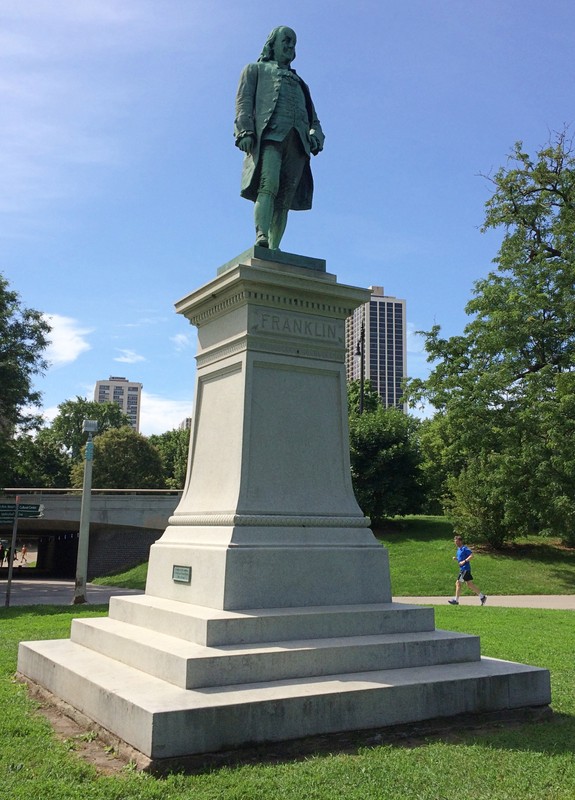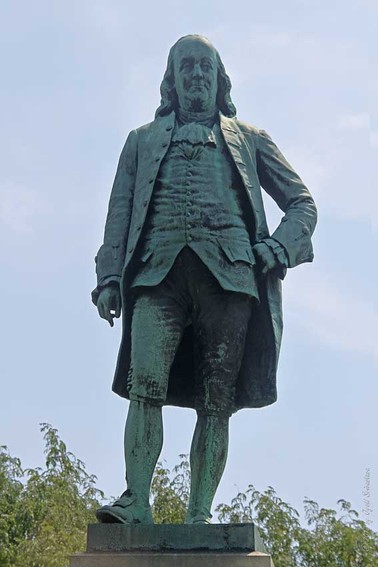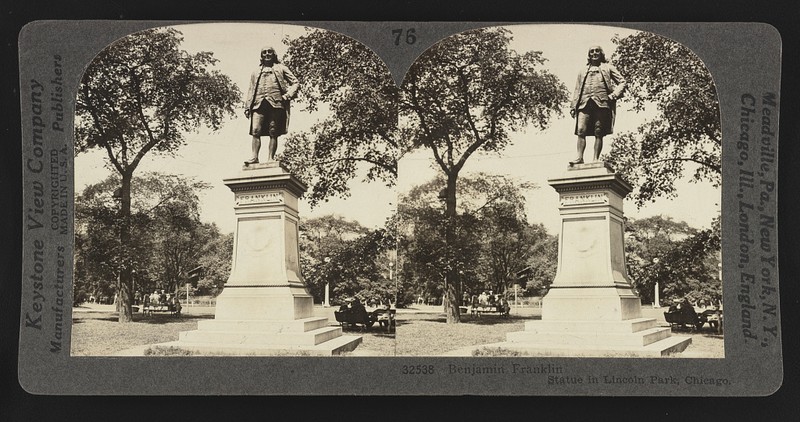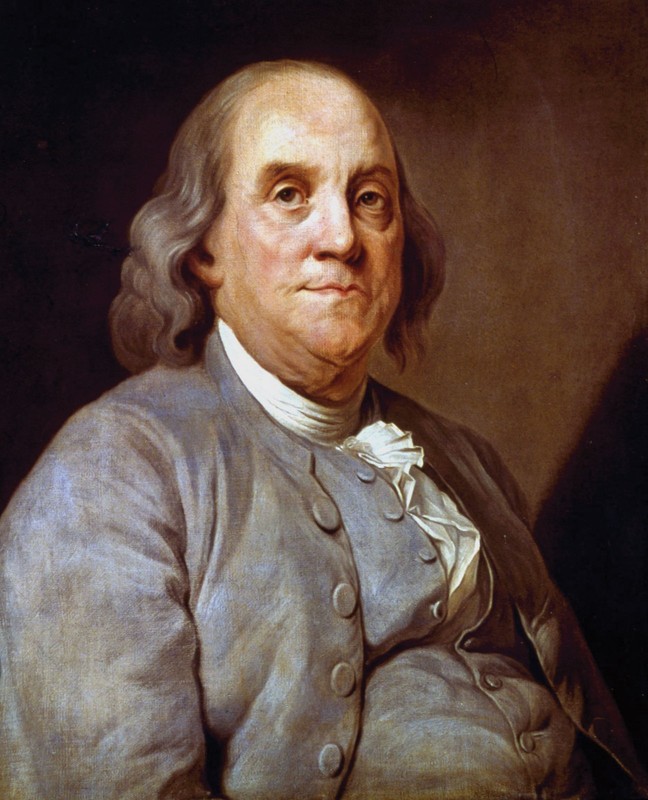Benjamin Franklin Monument
Introduction
Text-to-speech Audio
Images
Benjamin Franklin Monument in Chicago's Lincoln Park

A closer look at the bronze statue

A photograph of the monument in 1930

Benjamin Franklin (1706-1790)

Backstory and Context
Text-to-speech Audio
Benjamin Franklin was born to a large, humble Boston family on January 17, 1706. His father, Josiah Franklin, was an English-born candle and soap maker. Despite receiving very little formal education during his early years, he was a voracious reader and developed into a skilled writer. When he was twelve years old, Franklin began an apprenticeship under his older brother James, a printer in the city. In 1723, after a dispute with James, he left his apprenticeship and moved to New York City. Unable to find work, Franklin relocated to Philadelphia, where he found work as a printer. In late 1724, he removed to London, but after less than two years returned to Philadelphia. After briefly working as a clerk, Franklin opened a printing shop, which became highly lucrative. In addition to printing books, currency, and government pamphlets, he published the popular Pennsylvania Gazette beginning in 1729 and Poor Richard’s Almanack starting three years later. Franklin also setup franchises or partnerships with printers all across British North America and invested in rental properties in Philadelphia. By the late 1740s, he had become one of the wealthiest men in the American colonies and was thus able to retire from day-to-day business.
In the late 1740s and early 1750s, Franklin became increasingly engrossed in civic activities and scientific pursuits. He invented bifocals and the Franklin stove, and conducted experiments with electricity, the findings from which garnered him international fame. Additionally, Franklin served as a member of the Philadelphia City Council, a justice of the peace, a city alderman, and a member of the Pennsylvania Assembly. He also played a pivotal role in the founding of the Academy of Philadelphia in 1851, which four decades later would become known as the University of Pennsylvania.
Franklin, however, desired a greater public service role. In 1753, he became a royal officeholder when he secured an appointment as deputy postmaster general, a position that put him in charge of all mail in the northern half of the American colonies. The following year, as a delegate to the Albany Congress held at the start of the French and Indian War, Franklin proposed the Albany Plan of Union, which called for cooperation and collective action on the part of the American colonies against the French and their native allies. Although his plan was neither ratified by the colonial legislatures nor approved by the Crown, it laid the groundwork for colonial cooperation in the lead up to the American Revolution.
Nearly uninterrupted from 1757 until 1775, Franklin resided in London. While living in Great Britain carrying out his duties as deputy postmaster general of the American colonies, he received honorary doctorates for his scientific achievements from the University of Saint Andrews in Scotland in 1759 and the University of Oxford in 1762. After widespread American opposition to the implementation of the Stamp Act of 1765, Franklin testified before Parliament, calling for the law’s repeal. Perceived as too sympathetic to the American colonies, he was fired from his position as deputy postmaster general in January 1774. His reputation in England ruined, Franklin left London for the American colonies in March 1775.
Franklin contributed significantly to the American colonies’ quest for independence from Great Britain. Shortly after arriving in Philadelphia, he was elected a delegate to the Second Continental Congress. In 1776, Franklin served on the committee that drafted the Declaration of Independence. That same year, Congress sent him to Europe to seek diplomatic recognition and military aid from France. In 1778, Franklin’s hard work paid off when France recognized the United States and entered into a military alliance with the fledgling nation. Five years later, he helped to negotiate and draft the Treaty of Paris of 1783, which brought an end to the war and secured American independence.
Franklin left France and returned to the United States in 1785. He served as a delegate to the Constitutional Convention two years later. Franklin is the only man to have signed the Declaration of Independence, the Treaty of Paris of 1783, and the Constitution. He died in Philadelphia on April 17, 1790 at the age of eighty-four.
About a century later, the editor of the Chicago Tribune, Joseph Medill, took it upon himself to erect a monument in Franklin’s honor “to keep his memory fresh in the minds of Chicago’s youth.” In partnership with the Old-Time Printers’ Association, Medill commissioned sculptor Richard Henry Park to design it. Installed in 1896 on the east side of the Lincoln Park Zoo, the monument consists of a nine-and-a-half-foot-tall bronze statue of Franklin on a white granite pedestal. The sculpture depicts the Founding Father standing upright, his right leg slightly ahead of his left. Dressed in breeches, a waistcoat, and a knee-length coat, he looks slightly downward with a faint smirk on his face. In 1966, due to the zoo’s expansion, the Chicago Park District relocated the monument to its current location inside Lincoln Park.
Sources
"Benjamin Franklin Monument." Chicago Park District. City of Chicago. Web. 22 February 2021 <https://www.chicagoparkdistrict.com/parks-facilities/benjamin-franklin-monument>. (Quote from this source)
History.com Editors. "Benjamin Franklin." History. A&E Television Networks. 5 November 2020. Web. 22 February 2021 <https://www.history.com/topics/american-revolution/benjamin-franklin>.
Hornberger, Theodore and Gordon S. Wood. "Benjamin Franklin." Encyclopædia Britannica. Web. 22 February 2021 <https://www.britannica.com/biography/Benjamin-Franklin>.
http://www.dees-stribling.com/2019/08/27/a-few-lincoln-park-statues-and-wheres-garibaldi/
http://chicago-outdoor-sculptures.blogspot.com/2009/07/benjamin-franklin.html
https://www.loc.gov/item/2018649371/
https://www.britannica.com/biography/Benjamin-Franklin
